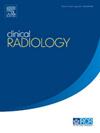Morphological changes in the muscle layer associated with invasion of bladder cancer
IF 2.1
3区 医学
Q2 RADIOLOGY, NUCLEAR MEDICINE & MEDICAL IMAGING
引用次数: 0
Abstract
AIM
Although multiparametric magnetic resonance imaging (mpMRI) has been validated for depth diagnosis of bladder cancer (BC), this study was performed to examine the morphological changes in the muscle layer in cases with BC and to re-evaluate the diagnostic capability of T2-weighted imaging (T2WI).
MATERIAL AND METHODS
The study population consisted of 89 patients with BC examined by preoperative MRI. Morphological findings in the muscle layer were compared between cases of muscle-invasive bladder cancer (MIBC) and non–muscle-invasive bladder cancer (NMIBC), and the sensitivity, specificity, positive predictive value (PPV), negative predictive value (NPV), and diagnostic accuracy of these findings were calculated.
RESULTS
Localised wall thickening, spinate elevation, and disruption or interruption were more common in MIBC, while NMIBC more commonly showed no such abnormal findings. In addition, the sensitivity, specificity, PPV, NPV, and diagnostic accuracy were 88.9%, 75.0%, 62.1%, 93.6%, and 79.4% for localised wall thickening; 96.0%, 93.8%, 87.6%, 98.1%, and 94.5% for spinate elevation; 100.0%, 83.6%, 73.7%, 100.0%, and 88.7% for disruption or interruption; and 72.9%, 98.1%, 94.6%, 88.8%, and 90.2% for any morphological changes.
CONCLUSION
Focussing on morphological changes in the bladder wall, T2WI may be useful for depth diagnosis of BC, as well as functional assessments such as diffusion-weighted imaging (DWI), dynamic contrast enhancement (DCE) imaging, and/or mpMRI such as VI-RADS.
膀胱癌侵袭后肌肉层形态学改变
目的:尽管多参数磁共振成像(mpMRI)已被证实可用于膀胱癌(BC)的深度诊断,但本研究旨在检查膀胱癌患者肌肉层的形态学变化,并重新评估t2加权成像(T2WI)的诊断能力。材料和方法研究人群包括89例术前MRI检查的BC患者。比较肌肉浸润性膀胱癌(MIBC)和非肌肉浸润性膀胱癌(NMIBC)的肌肉层形态学表现,并计算这些表现的敏感性、特异性、阳性预测值(PPV)、阴性预测值(NPV)和诊断准确性。结果局部壁增厚、脊柱抬高、断裂或中断在MIBC中更为常见,而NMIBC中更常见的是没有这些异常表现。局部壁增厚的敏感性、特异性、PPV、NPV和诊断准确率分别为88.9%、75.0%、62.1%、93.6%和79.4%;分别为96.0%、93.8%、87.6%、98.1%和94.5%;100.0%、83.6%、73.7%、100.0%和88.7%为中断或中断;形态学变化分别为72.9%、98.1%、94.6%、88.8%和90.2%。结论T2WI关注膀胱壁的形态学变化,可用于BC的深度诊断,以及功能评估,如弥漫性加权成像(DWI)、动态对比增强(DCE)成像和/或mpMRI(如VI-RADS)。
本文章由计算机程序翻译,如有差异,请以英文原文为准。
求助全文
约1分钟内获得全文
求助全文
来源期刊

Clinical radiology
医学-核医学
CiteScore
4.70
自引率
3.80%
发文量
528
审稿时长
76 days
期刊介绍:
Clinical Radiology is published by Elsevier on behalf of The Royal College of Radiologists. Clinical Radiology is an International Journal bringing you original research, editorials and review articles on all aspects of diagnostic imaging, including:
• Computed tomography
• Magnetic resonance imaging
• Ultrasonography
• Digital radiology
• Interventional radiology
• Radiography
• Nuclear medicine
Papers on radiological protection, quality assurance, audit in radiology and matters relating to radiological training and education are also included. In addition, each issue contains correspondence, book reviews and notices of forthcoming events.
 求助内容:
求助内容: 应助结果提醒方式:
应助结果提醒方式:


